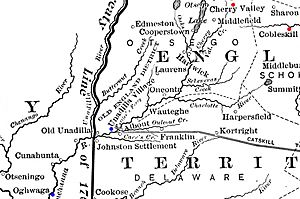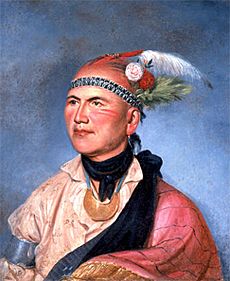Battle of Cobleskill facts for kids
Quick facts for kids Battle of Cobleskill |
|||||||
|---|---|---|---|---|---|---|---|
| Part of the American Revolutionary War | |||||||
 Map detail showing the western frontier of New York. Cobleskill and Cherry Valley are marked in red, Unadilla and Onaquaga (spelled "Oghwaga" on the map) are marked in blue. |
|||||||
|
|||||||
| Belligerents | |||||||
Iroquois |
|||||||
| Commanders and leaders | |||||||
| Joseph Brant | William Patrick † Christian Brown |
||||||
| Strength | |||||||
| 200–300 Loyalists and Iroquois | 30–40 regulars 15–20 militia |
||||||
| Casualties and losses | |||||||
| 25 killed | 22 killed 8 wounded 5 captured |
||||||
The Battle of Cobleskill was a surprise attack during the American Revolutionary War. It happened on May 30, 1778, in a small settlement called Cobleskill, New York. This battle started a new phase of the war on the western edge of New York and Pennsylvania.
During this time, Loyalists (Americans who supported the British) and Iroquois warriors began raiding and destroying many villages. They were encouraged and supplied by the British in Quebec.
In the battle, a small group of Iroquois tricked the local defenders into a trap. A much larger force of Iroquois and Loyalists, led by Joseph Brant, was waiting. After many defenders were killed or driven away, Brant's forces destroyed most of the settlement. Later, American forces fought back by destroying Iroquois villages. This included the Sullivan Expedition in 1779.
Contents
Why the Battle Happened
The War Moves West
After the Battles of Saratoga in October 1777, the war in upstate New York changed. It became a frontier war, fought on the edges of settled areas. British leaders in Quebec supported Loyalists and Native American fighters. They gave them supplies and weapons.
Brant's Plans
During the winter of 1777–78, Joseph Brant and other Native American allies of the British made plans. They wanted to attack frontier settlements in New York and Pennsylvania. In February 1778, Brant set up a base at Onaquaga (now Windsor, New York).
He gathered a force of Iroquois and Loyalists. By May, his group had about 200 to 300 fighters. One of his goals was to get food and supplies for his forces. He also aimed to help John Butler, another Loyalist leader, who was planning attacks in the Susquehanna River valley.
Cobleskill's Defenses
In 1778, Cobleskill was a small farming community. About twenty families lived on farms along Cobleskill Creek. This area was important because it provided a lot of food for the American war effort.
The main defense for Cobleskill was a small local group of citizen soldiers called the militia. They were led by Captain Christian Brown. When rumors of Iroquois attacks spread in the spring of 1778, the militia asked for more help. The Continental Army sent Captain William Patrick with 30 to 40 men from his 7th Massachusetts Regiment to help defend the settlement.
The Battle of Cobleskill

On the morning of May 30, Joseph Brant set a trap for the defenders of Cobleskill. He sent a small number of Native Americans forward to act as a lure. Captain Patrick's soldiers and the local militia saw them near the southern edge of the settlement.
Captain Brown warned that it might be a trap. However, Captain Patrick pushed forward as the Native Americans seemed to retreat. They chased them for about one mile (1.6 km). Then, Brant's trap was sprung. Patrick's company was suddenly surrounded by Brant's much larger force.
Both Captain Patrick and his second-in-command were killed. About half of their soldiers also died in the battle. Captain Brown quickly organized the remaining forces. They fought their way back towards the settlement. Five men tried to hide in George Warner's house, but the attackers set it on fire, killing all five. In total, 22 settlers were killed, eight were wounded, and five were captured by Brant's men. Brant's force had about 25 casualties.
After the Battle
Destruction and Retreat
After the battle, Brant and his men burned ten houses and other farm buildings. They also killed any cattle they could not take with them. Brant took five prisoners. These prisoners were later held by British authorities in Quebec until the war ended.
Brant continued to gather more fighters and raid other frontier communities in the Mohawk Valley. He thought about attacking Cherry Valley next. But because the militia there was on high alert, he decided to go back to Iroquois territory instead. Cherry Valley was later attacked in November in what became known as the Cherry Valley massacre.
American Response
New York Governor George Clinton had already been planning operations against Onaquaga. After the Cobleskill raid and Brant's attack on German Flatts in September, he expanded his plans. In October 1778, American soldiers and militia destroyed Onaquaga and Unadilla. These were other Native American villages that supported Brant and Butler.
Helping the Settlers
The settlers of Cobleskill who lost everything received £200 to help them. People from many nearby communities started moving to larger, safer places. These included Cherry Valley, which began building a fort after the raid, and Schenectady.
The attacks by Brant and Butler helped convince the Continental Congress to approve a major military expedition. This was the Sullivan Expedition in 1779, led by Generals John Sullivan and James Clinton. This expedition systematically destroyed the villages of Iroquois tribes who fought for the British. However, it did not completely stop the frontier war.
Images for kids



